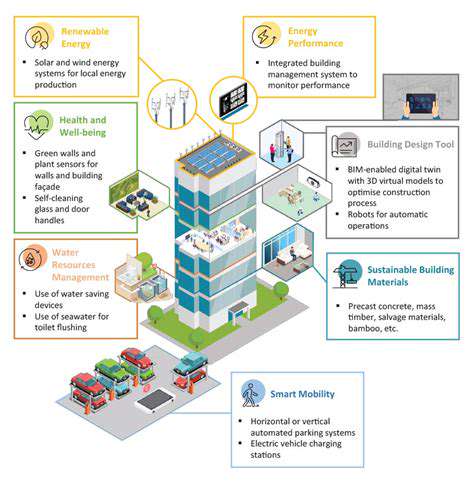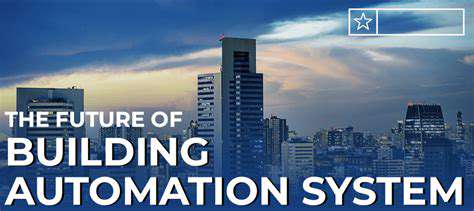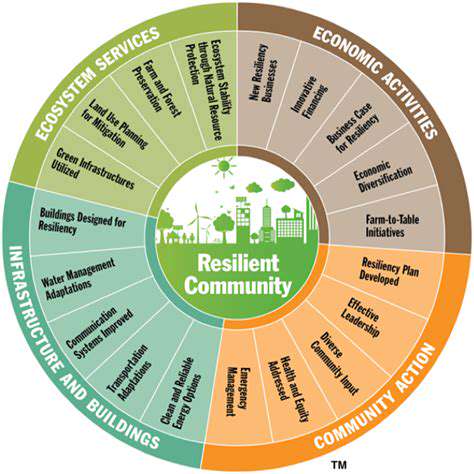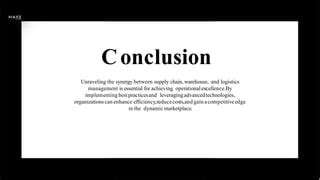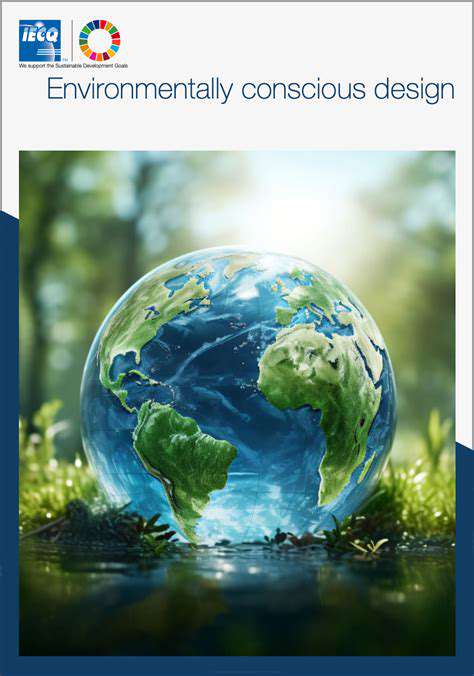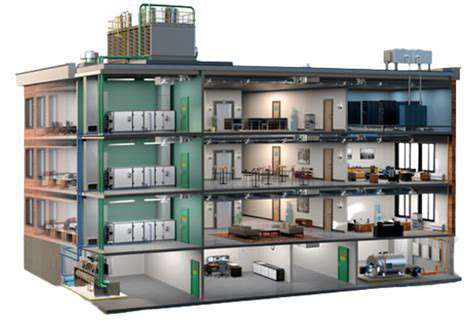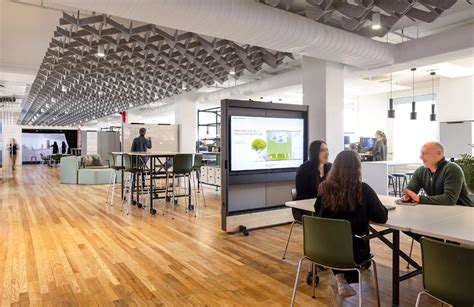WELL Building Standard: Healthier Real Estate
Improved Indoor Air Quality
The WELL Building Standard prioritizes superior indoor air quality (IAQ), recognizing its profound impact on occupant health and well-being. This commitment extends beyond basic ventilation standards, incorporating strategies like enhanced filtration systems, optimized humidity control, and the management of volatile organic compounds (VOCs). Reduced allergens, pollutants, and odors contribute to a healthier, more productive environment for those occupying the space, leading to noticeable improvements in respiratory health and overall comfort.
Beyond the immediate effects, improved IAQ can lead to long-term health benefits, potentially reducing the incidence of respiratory illnesses and allergies. This proactive approach to air quality aligns with the WELL Standard's broader goal of creating spaces that promote and support human health and well-being.
Enhanced Thermal Comfort
WELL addresses thermal comfort by encouraging design strategies that proactively manage temperature, humidity, and air movement. This proactive approach goes beyond simply providing heating and cooling, aiming to create a microclimate that optimizes occupant comfort and reduces stress on the body's thermoregulatory system. This includes careful consideration of building orientation, insulation, and natural ventilation strategies.
By optimizing thermal conditions, the WELL Building Standard contributes to a more productive and focused work environment. Reduced discomfort from extreme temperatures or fluctuating conditions allows occupants to concentrate better, minimizing stress and increasing comfort throughout the workday.
Optimized Natural Light and Views
The WELL Building Standard recognizes the importance of natural light and views in creating a more positive and productive environment. This goes beyond aesthetic appeal, acknowledging the profound impact of natural light on human circadian rhythms and mood regulation. Properly designed windows and daylighting strategies are integral to optimizing natural light and views.
Exposure to natural light has been shown to improve mood, reduce stress, and enhance overall well-being. WELL's emphasis on natural light integration creates spaces that are not only visually appealing but also promote a more positive and healthy environment for occupants.
Promoting Active Spaces
WELL encourages the incorporation of active spaces within buildings, recognizing the importance of movement and physical activity. This extends beyond simply having a gym or fitness center, encompassing strategies like creating stairwells that encourage use, incorporating movement-friendly layouts, and promoting active transportation options. The goal is to seamlessly weave opportunities for physical activity into the daily routines of building occupants.
By making it easier for occupants to incorporate physical activity into their day, WELL contributes to improved physical and mental health outcomes. This proactive approach to health and wellness goes beyond passive considerations and actively promotes a more active lifestyle.
Prioritizing Acoustics and Sound Design
The WELL Standard takes a keen interest in acoustic design, recognizing the impact of noise levels on occupant well-being. It promotes strategies for reducing noise pollution, whether from external sources or internal building activities. This includes implementing sound-absorbing materials, optimizing building design to minimize noise transmission, and creating quiet zones within the building.
Sound design plays a crucial role in ensuring a healthy and productive work environment. By minimizing noise and maximizing quiet zones, WELL supports focus, reduces stress, and promotes overall well-being.
Material Selection and Air Quality
WELL places significant emphasis on the selection of materials used in construction and their potential impact on indoor air quality and occupant health. The standard promotes the use of low-emitting materials, minimizing the release of harmful chemicals and pollutants. This conscious selection process aims to create spaces that are not only aesthetically pleasing but also safe and conducive to healthy living and working.
Careful consideration of materials extends beyond just aesthetics to encompass the health implications of the choices made. This proactive approach to material selection helps create a healthy building environment that supports occupants' well-being and fosters a more sustainable approach to design.
Accessibility and Universal Design
WELL recognizes the importance of creating spaces that are accessible to all occupants, regardless of their abilities or needs. This concept extends beyond simply meeting legal accessibility requirements; it emphasizes the design and implementation of universal design principles that enhance the comfort and ease of use for all. This includes considerations for diverse needs, promoting a sense of inclusivity, and enhancing the overall user experience.
A focus on universal design fosters inclusivity and enhances the experience for all users, creating spaces that are comfortable, accessible, and supportive for everyone. By acknowledging and accommodating a wide range of needs, WELL promotes a more equitable and user-friendly environment.
How WELL Certification Benefits Real Estate Development
Improved Building Performance and Efficiency
Implementing the WELL Building Standard leads to significant improvements in building performance, impacting everything from energy efficiency to indoor air quality. This translates to lower operational costs for developers, as well as enhanced comfort and productivity for occupants. Reduced energy consumption directly contributes to a smaller carbon footprint, demonstrating a commitment to sustainability and environmental responsibility. These performance gains often lead to a positive return on investment, making WELL certified buildings more attractive to tenants and investors.
Furthermore, WELL certification encourages the integration of innovative technologies and design elements that optimize building systems. This proactive approach anticipates and addresses future needs, ensuring the building remains relevant and efficient for years to come. A focus on healthy building practices ultimately fosters a more sustainable and resilient development.
Enhanced Occupant Health and Well-being
A primary focus of the WELL Building Standard is the well-being of building occupants. By prioritizing factors like natural light, fresh air, and access to green spaces, developers create healthier and more productive environments. This not only boosts employee morale and reduces absenteeism but also fosters a positive impact on overall health outcomes for the community.
WELL certification goes beyond basic comfort, proactively addressing factors like stress reduction, improved sleep quality, and enhanced cognitive function. By integrating these elements into the design and operation of the building, developers create a truly holistic approach to occupant well-being.
Increased Tenant Attraction and Retention
In today's competitive real estate market, attracting and retaining tenants is crucial. WELL certified buildings stand out as a symbol of quality, sustainability, and occupant well-being. This distinctive feature significantly enhances the appeal of a property, making it more attractive to a wider range of potential tenants.
Tenants are increasingly seeking properties that prioritize their health and well-being. WELL certification directly addresses these needs, creating a competitive edge for developers and attracting high-quality tenants. The certification acts as a powerful marketing tool, demonstrating a commitment to creating a superior and healthy environment.
Improved Sustainability Practices
The WELL Building Standard promotes environmentally conscious design and operations. Developers are encouraged to reduce their environmental impact by minimizing resource consumption, promoting sustainable materials, and implementing energy-efficient technologies. These practices align with the growing demand for environmentally responsible real estate development.
Enhanced Brand Reputation and Value
WELL certification enhances a developer's brand reputation by demonstrating a commitment to health, sustainability, and innovation. This positive perception resonates with investors, tenants, and the wider community. The certification creates a valuable asset, adding significant value to the property and increasing its marketability.
Compliance with Growing Regulatory Requirements
The increasing awareness and emphasis on building health and sustainability are driving the adoption of standards like WELL. Developers who embrace WELL certification position themselves for future regulatory requirements and market trends. This proactive approach ensures compliance with evolving building codes and regulations, minimizing potential future challenges and legal liabilities.
The Future of Real Estate: A WELL-Informed Approach
The Growing Importance of WELL Building Standard
The WELL Building Standard is rapidly gaining traction as a crucial factor in the future of real estate development. It's no longer just a trend; it's a significant driver in attracting and retaining tenants, particularly in the increasingly health-conscious modern world. Developers and investors are recognizing that incorporating WELL principles not only enhances the quality of life for occupants but also positively impacts building performance, reducing operational costs and increasing property value in the long run. This forward-thinking approach reflects a shift in the industry towards prioritizing occupant well-being and sustainable practices.
The WELL Building Standard goes beyond traditional building codes, focusing on the environmental and health aspects of the built environment. This holistic approach encompasses factors like air quality, natural light, access to green spaces, and even the psychological impact of the design on occupants. By addressing these diverse facets, the WELL Standard fosters a healthier, more productive, and ultimately more appealing environment for everyone who interacts with the building.
Integrating WELL into the Real Estate Development Process
Integrating the WELL Building Standard into the real estate development process requires a conscious and proactive approach. Developers need to understand the various aspects of the standard, from the initial design phases to construction and ongoing maintenance. This involves collaborating with architects, engineers, and other stakeholders to ensure seamless implementation of the WELL principles. Early adoption of the WELL criteria can influence design choices, from material selection and ventilation systems to the incorporation of natural light and green spaces. This thoughtful integration is key to creating buildings that genuinely prioritize the well-being of their occupants.
Beyond the initial design, continuous monitoring and evaluation are essential for maintaining a WELL-certified building. This might involve tracking indoor air quality, measuring occupant satisfaction, and adjusting building systems to optimize the comfort and health of the inhabitants. By actively participating in the ongoing evaluation process, developers can demonstrate their commitment to the well-being of their tenants and strengthen their market position.
The Financial Advantages of WELL Certification
The WELL Building Standard isn't just about occupant health; it also offers significant financial advantages for real estate projects. Buildings certified under the WELL Standard often attract a higher caliber of tenants, leading to increased rental rates and occupancy rates. The improved health and productivity of tenants can translate into lower healthcare costs associated with the workforce and potentially reduced absenteeism. This overall positive impact on the building's operational costs contributes to a more profitable and sustainable investment.
Furthermore, WELL certification can enhance the building's marketability and appeal to investors. The growing awareness of the WELL Standard among potential buyers and renters adds significant value to properties. This increased demand and higher perceived value can lead to higher property valuations and quicker sale times, making WELL certification a smart investment strategy for the future of real estate.
Read more about WELL Building Standard: Healthier Real Estate
Hot Recommendations
- AI in Property Marketing: Virtual Tours and VR
- Water Management Solutions for Sustainable Real Estate
- IoT Solutions for Smart Building Energy Management
- Sustainable Real Estate: Building a Greener Tomorrow
- Sustainable Real Estate: From Concept to Community
- AI Driven Due Diligence for Large Scale Developments
- Real Estate Sector and Global Climate Agreements
- Smart Buildings: The Key to Smarter Property Management
- Zero Waste Buildings: A Sustainable Real Estate Goal
- Understanding Climate Risk in Real Estate Financing
